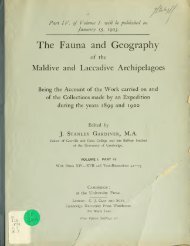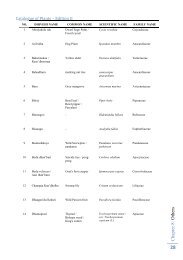Download - WordPress – www.wordpress.com
Download - WordPress – www.wordpress.com
Download - WordPress – www.wordpress.com
You also want an ePaper? Increase the reach of your titles
YUMPU automatically turns print PDFs into web optimized ePapers that Google loves.
THE ENTEROPXEUSTA. 665There is more irregularity here in the figures for the genito-hepatic length and totallength, which perhaps is only to be expected in view of the smaller number of specimens.There is however no uniformity indicating a gi-owth change. The value for group 3 in thebranchial series is far larger than f(5i' groups 1 and 2. This however is due to the largebranchial region of a single specimen (Table 13, No. 49) and its effect on the few individualsof group 3. The closeness of the figures for gi-oups 1 and 2 (I'GS to 1-62), where thereare more specimens available, points to the ratio of branchial length to collar not beingaffected by gi-owth changes. Assuming then, and the assumption seems a fair one, thatgrowth has little or no effect on the relative proportions of the body in Ptychodera we havebefore us an easily applied criterion for distinguishing different positions of organic stabilityin this genus. We have but to determine one of these ratios (and in practice the branchialone will be found the most convenient) on a number of specimens of each supposed variety,and to apply to the series so obtained the ordinary biometric methods for measuring thevariability. Marked differences occurring in two groups of specimens would at once cast adoubt on the identity of two such groups.This method has been adopted here for such of the varieties as possessed nine or morespecimens. The branchial ratio alone was used owing to the fragmentary condition of mostof the individuals in each variety. On working out the mean and standard deviation ineach case the following results were obtained :Table 8.'






